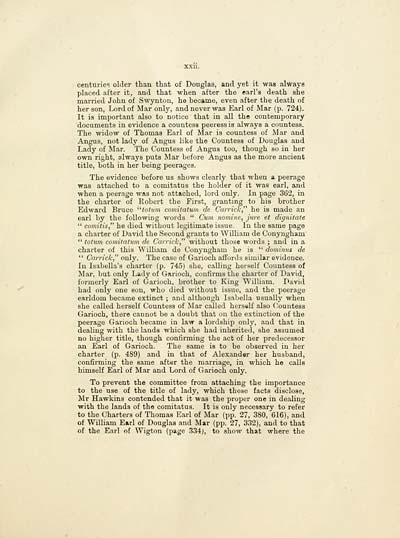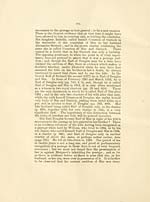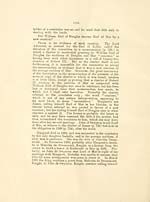Paper on the Mar peerage
(51) Page xxii
Download files
Complete book:
Individual page:
Thumbnail gallery: Grid view | List view

centuries older than that of Douglas, and yet it was always
placed after it, and that when after the earl's death she
married John of Swynton, he became, even after the death of
her son, Lord of Mar only, and never was Earl of Mar (p. 724).
It is important also to notice that in all the contemporary
documents in evidence a countess peeress is always a countess.
The widow of Thomas Earl of Mar is countess of Mar and
Angus, not lady of Angus like the Countess of Douglas and
Lady of Mar. The Countess of Angus too, though so in her
own right, always puts Mar before Angus as the more ancient
title, both in her being peerages.
The evidence before us shows clearly that when a peerage
was attached to a comitatus the holder of it was earl, and
when a peerage was not attached, lord only. In page 362, in
the charter of Robert the First, granting to his brother
Edward Bruce "totum comitatum de Carrick," he is made an
earl by the following words " Cum nomine, jure et dignitate
" comitis," he died without legitimate issue. In the same page
a charter of David the Second grants to William de Conyngham
" totum comitatum de Carrick," without those words ; and in a
charter of this William de Conyngham he is " dominus de
" Carrick," only. The case of Garioch affords similar evidence.
In Isabella's charter (p. 745) she, calling herself Countess of
Mar, but only Lady of Garioch, confirms the charter of David,
formerly Earl of Garioch, brother to King William. David
had only one son, who died without issue, and the peerage
earldom became extinct ; and although Isabella usually when
she called herself Countess of Mar called herself also Countess
Garioch, there cannot be a doubt that on the extinction of the
peerage Garioch became in law a lordship only, and that in
dealing with the lands which she had inherited, she assumed
no higher title, though confirming the act of her predecessor
an Earl of Garioch. The same is to be observed in her
charter (p. 489) and in that of Alexander her husband,
confirming the same after the marriage, in which he calls
himself Earl of Mar and Lord of Garioch only.
To prevent the committee from attaching the importance
to the use of the title of lady, which these facts disclose,
Mr Hawkins contended that it was the proper one in dealing
with the lands of the comitatus. It is only necessary to refer
to the Charters of Thomas Earl of Mar (pp. 27, 380, 616), and
of William Earl of Douglas and Mar (pp. 27, 332), and to that
of the Earl of Wigton (page 334), to show that where the
placed after it, and that when after the earl's death she
married John of Swynton, he became, even after the death of
her son, Lord of Mar only, and never was Earl of Mar (p. 724).
It is important also to notice that in all the contemporary
documents in evidence a countess peeress is always a countess.
The widow of Thomas Earl of Mar is countess of Mar and
Angus, not lady of Angus like the Countess of Douglas and
Lady of Mar. The Countess of Angus too, though so in her
own right, always puts Mar before Angus as the more ancient
title, both in her being peerages.
The evidence before us shows clearly that when a peerage
was attached to a comitatus the holder of it was earl, and
when a peerage was not attached, lord only. In page 362, in
the charter of Robert the First, granting to his brother
Edward Bruce "totum comitatum de Carrick," he is made an
earl by the following words " Cum nomine, jure et dignitate
" comitis," he died without legitimate issue. In the same page
a charter of David the Second grants to William de Conyngham
" totum comitatum de Carrick," without those words ; and in a
charter of this William de Conyngham he is " dominus de
" Carrick," only. The case of Garioch affords similar evidence.
In Isabella's charter (p. 745) she, calling herself Countess of
Mar, but only Lady of Garioch, confirms the charter of David,
formerly Earl of Garioch, brother to King William. David
had only one son, who died without issue, and the peerage
earldom became extinct ; and although Isabella usually when
she called herself Countess of Mar called herself also Countess
Garioch, there cannot be a doubt that on the extinction of the
peerage Garioch became in law a lordship only, and that in
dealing with the lands which she had inherited, she assumed
no higher title, though confirming the act of her predecessor
an Earl of Garioch. The same is to be observed in her
charter (p. 489) and in that of Alexander her husband,
confirming the same after the marriage, in which he calls
himself Earl of Mar and Lord of Garioch only.
To prevent the committee from attaching the importance
to the use of the title of lady, which these facts disclose,
Mr Hawkins contended that it was the proper one in dealing
with the lands of the comitatus. It is only necessary to refer
to the Charters of Thomas Earl of Mar (pp. 27, 380, 616), and
of William Earl of Douglas and Mar (pp. 27, 332), and to that
of the Earl of Wigton (page 334), to show that where the
Set display mode to:
![]() Universal Viewer |
Universal Viewer | ![]() Mirador |
Large image | Transcription
Mirador |
Large image | Transcription
Images and transcriptions on this page, including medium image downloads, may be used under the Creative Commons Attribution 4.0 International Licence unless otherwise stated. ![]()
| Histories of Scottish families > Paper on the Mar peerage > (51) Page xxii |
|---|
| Permanent URL | https://digital.nls.uk/94944422 |
|---|
| Description | A selection of almost 400 printed items relating to the history of Scottish families, mostly dating from the 19th and early 20th centuries. Includes memoirs, genealogies and clan histories, with a few produced by emigrant families. The earliest family history goes back to AD 916. |
|---|

